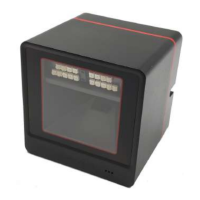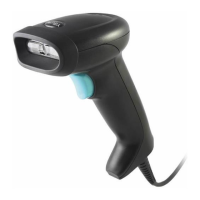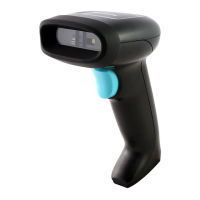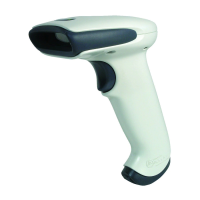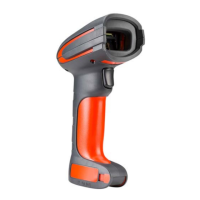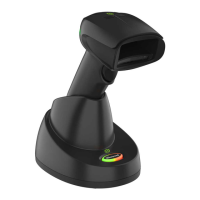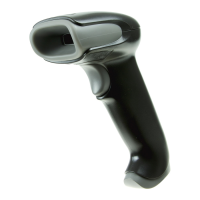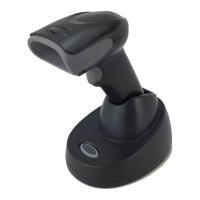Do you have a question about the Honeywell HF680 and is the answer not in the manual?
Provides installation and programming instructions for HF680 series scanners.
Information specific to the HF680 Second Generation model usage.
Steps for safely unpacking the scanner and checking contents.
Instructions for connecting the scanner via USB and RS232 serial ports.
Guidance on optimizing barcode reading based on symbology and reflectivity.
How to restrict access to menu programming barcodes for security.
Steps to create and save custom default scanner settings.
Overview of how to program the scanner for desired host interfaces.
Instant scanner setup for common interfaces using Plug and Play barcodes.
Settings for connecting and programming the scanner via RS232 serial port.
Programming the scanner for IBM SurePos (handheld/tabletop) USB interfaces.
Configuring scanner for USB PC or Macintosh keyboard emulation.
Programming the scanner for USB HID (Human Interface Device) applications.
Configuring the scanner to emulate a standard RS232-based COM port via USB.
Enabling or disabling CTS/RTS hardware flow control for serial communication.
Configuring the scanner to use ACK/NAK acknowledgment protocol.
Configuring scanner for communication with management software via USB.
Setting the keyboard layout for different countries for USB interfaces.
Options for modifying keyboard wedge behavior, including ALT Mode.
Using ALT Mode for scanning special characters from the extended ASCII chart.
Configuring keyboard styles like Caps Lock and Shift Lock.
Forcing alphabetic characters to uppercase or lowercase.
Sending text strings instead of control characters for output.
Configuring special keyboard features like CTRL+ASCII codes and Turbo Mode.
Adjusting RS232 communication parameters like baud rate and data format.
Configure scanner beep behavior for good reads, errors, volume, and pitch.
Configure LED behavior for good reads and number of flashes.
Configure scanner activation via IR sensor or serial commands.
Set delays for reads, rereads, and timeouts to optimize scanning.
Configure scanner behavior for automatic presentation scanning.
Improve scanner performance for damaged or poor quality barcodes.
Control scanner scanning using specific characters.
Manage scanner illumination and notification for unreadable barcodes.
Adjust scanner for inverted barcodes and barcode orientation.
Understanding how prefixes and suffixes build the scanner's message string.
Learn how to add, clear, and manage prefixes and suffixes for symbologies.
Enable or disable transmission of function codes within scanned data.
Configure delays between data transmissions to ensure data integrity.
Introduction to using the Data Format Editor to change scanner output.
Learn to view, add, clear, and manage scanner data formats.
Commands for manipulating the cursor and data within the editor.
Commands to output characters, numbers, or specific character sequences.
Commands to move the cursor forward, backward, or to the beginning/end.
Commands to search forward or backward for specific characters.
Commands for suppressing characters, replacing characters, and checking data.
Overview of symbologies, enabling/disabling all, and message length.
Settings for linear barcodes like Codabar, Code 39, UPC, EAN, etc.
Settings for 2D barcodes like Data Matrix, QR Code, MaxiCode, Aztec.
Settings for various postal barcode types.
Configure scanner to emulate GS1 data carriers for data formatting.
Temporarily add a Code I.D. prefix to all symbologies for testing.
Display scanner software revision, serial number, and product information.
Display current data format settings configured on the scanner.
Use the test menu to view programming code content during operation.
Using PC software to configure scanner, download upgrades, and manage parameters.
Restore scanner settings to original factory defaults.
Understanding the syntax and conventions used for command descriptions.
Explanation of the structure and syntax for menu commands.
Using special characters to query the scanner about its settings.
Issuing multiple commands within a single sequence for efficiency.
Practical examples demonstrating how to query scanner settings.
Serial commands to activate and deactivate the scanner's trigger.
Detailed specifications for HF680 (2nd Gen), HF680E, and HF680M models.
Charts showing scanner read distance performance for various symbologies.
Pin assignments and details for serial and USB interfaces.
Location and identification of essential safety labels on the scanner.
Procedures for scanner maintenance, cleaning, and cable replacement.
Guide to diagnosing and resolving common scanner operational problems.
Tables detailing symbology IDs, modifiers, and hex values.
Charts for ASCII conversion, character replacements, and keyboard layouts.
Visual examples of various barcode symbologies for identification.
Reference for scanning programming barcodes for configuration.
Provides installation and programming instructions for HF680 series scanners.
Information specific to the HF680 Second Generation model usage.
Steps for safely unpacking the scanner and checking contents.
Instructions for connecting the scanner via USB and RS232 serial ports.
Guidance on optimizing barcode reading based on symbology and reflectivity.
How to restrict access to menu programming barcodes for security.
Steps to create and save custom default scanner settings.
Overview of how to program the scanner for desired host interfaces.
Instant scanner setup for common interfaces using Plug and Play barcodes.
Settings for connecting and programming the scanner via RS232 serial port.
Programming the scanner for IBM SurePos (handheld/tabletop) USB interfaces.
Configuring scanner for USB PC or Macintosh keyboard emulation.
Programming the scanner for USB HID (Human Interface Device) applications.
Configuring the scanner to emulate a standard RS232-based COM port via USB.
Enabling or disabling CTS/RTS hardware flow control for serial communication.
Configuring the scanner to use ACK/NAK acknowledgment protocol.
Configuring scanner for communication with management software via USB.
Setting the keyboard layout for different countries for USB interfaces.
Options for modifying keyboard wedge behavior, including ALT Mode.
Using ALT Mode for scanning special characters from the extended ASCII chart.
Configuring keyboard styles like Caps Lock and Shift Lock.
Forcing alphabetic characters to uppercase or lowercase.
Sending text strings instead of control characters for output.
Configuring special keyboard features like CTRL+ASCII codes and Turbo Mode.
Adjusting RS232 communication parameters like baud rate and data format.
Configure scanner beep behavior for good reads, errors, volume, and pitch.
Configure LED behavior for good reads and number of flashes.
Configure scanner activation via IR sensor or serial commands.
Set delays for reads, rereads, and timeouts to optimize scanning.
Configure scanner behavior for automatic presentation scanning.
Improve scanner performance for damaged or poor quality barcodes.
Control scanner scanning using specific characters.
Manage scanner illumination and notification for unreadable barcodes.
Adjust scanner for inverted barcodes and barcode orientation.
Understanding how prefixes and suffixes build the scanner's message string.
Learn how to add, clear, and manage prefixes and suffixes for symbologies.
Enable or disable transmission of function codes within scanned data.
Configure delays between data transmissions to ensure data integrity.
Introduction to using the Data Format Editor to change scanner output.
Learn to view, add, clear, and manage scanner data formats.
Commands for manipulating the cursor and data within the editor.
Commands to output characters, numbers, or specific character sequences.
Commands to move the cursor forward, backward, or to the beginning/end.
Commands to search forward or backward for specific characters.
Commands for suppressing characters, replacing characters, and checking data.
Overview of symbologies, enabling/disabling all, and message length.
Settings for linear barcodes like Codabar, Code 39, UPC, EAN, etc.
Settings for 2D barcodes like Data Matrix, QR Code, MaxiCode, Aztec.
Settings for various postal barcode types.
Configure scanner to emulate GS1 data carriers for data formatting.
Temporarily add a Code I.D. prefix to all symbologies for testing.
Display scanner software revision, serial number, and product information.
Display current data format settings configured on the scanner.
Use the test menu to view programming code content during operation.
Using PC software to configure scanner, download upgrades, and manage parameters.
Restore scanner settings to original factory defaults.
Understanding the syntax and conventions used for command descriptions.
Explanation of the structure and syntax for menu commands.
Using special characters to query the scanner about its settings.
Issuing multiple commands within a single sequence for efficiency.
Practical examples demonstrating how to query scanner settings.
Serial commands to activate and deactivate the scanner's trigger.
Detailed specifications for HF680 (2nd Gen), HF680E, and HF680M models.
Charts showing scanner read distance performance for various symbologies.
Pin assignments and details for serial and USB interfaces.
Location and identification of essential safety labels on the scanner.
Procedures for scanner maintenance, cleaning, and cable replacement.
Guide to diagnosing and resolving common scanner operational problems.
Tables detailing symbology IDs, modifiers, and hex values.
Charts for ASCII conversion, character replacements, and keyboard layouts.
Visual examples of various barcode symbologies for identification.
Reference for scanning programming barcodes for configuration.
| Scan Pattern | Area Image (1280 x 800 pixel array) |
|---|---|
| Humidity | 0% to 95% relative humidity, non-condensing |
| Standby Power | 0.45 W (90 mA @ 5 VDC) |
| Light Levels | 0 to 100, 000 lux |
| Decode Capability | Reads standard 1D, PDF, 2D, Postal and OCR symbologies |
| Interface | USB, RS232, Keyboard Wedge |
| Operating Temperature | 0°C to 50°C (32°F to 122°F) |
| Storage Temperature | -40°F to 158°F (-40°C to 70°C) |
| Drop | Designed to withstand 1.5 m (5 ft) drops |
| Input Voltage | 4.0 V DC to 5.5 V DC |
